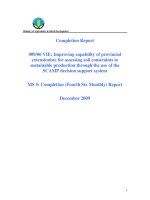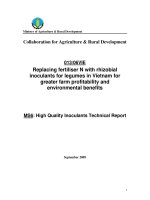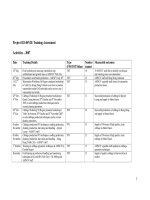Báo cáo khoa học nông nghiệp " Improving capability of provincial extensionists for assessing soil constraints to sustainable production through the use of the SCAMP decision support system ( Attachment 2 )" pdf
Bạn đang xem bản rút gọn của tài liệu. Xem và tải ngay bản đầy đủ của tài liệu tại đây (21.06 KB, 5 trang )
009/06 VIE Final Report 2009 Attachment 2
1
009/06 VIE: Improving capability of provincial extensionists for assessing soil constraints to
sustainable production through the use of the SCAMP decision support system.
SCAMP Training Course Tay Ninh
February , 2009
Pre- and post- training survey
The 27 participants at the training course were given a pre- and post-course questionnaire. The pre-
course questionnaire was designed to determine what the participants considered were the major
soil constraints to productivity in their villages. The post-course questionnaire was designed to
measure any changed perceptions of major soil constraints and to determine what follow-up actions
the participants planned to take when they returned from the course.
Pre-course survey
Sandy soil is one of the major cropping soil groups of Tay Ninh province. The structure of soil is
weak and loose. This results in low water holding capacity and poor soil fertility. As a consequence,
productive capacity can be seriously constrained.
Questions Participants
(%)
1. What are the main crops grown in your location?
Fruit
Peanut
Maize
Vegetable
Sugar
Rubber
Cashew
Flower
Cassava
Tobacco
Pepper
Coffee
Grass
44
44
41
41
33
30
26
26
26
15
11
9
7
2. What are the soil groups? Participants
(%)
Fluvisols
Gleysols
Acrisols
Ferralsols
Clay loam
Loam
Clays
96
77
44
19
26
22
11
009/06 VIE Final Report 2009 Attachment 2
2
Sandy soils
4
3. What are the constraints to productive agricultural systems? Participants
(%)
Weak soil structure and erosion
Shallow topsoil
No organic amendments are applied
Cultivation system is unsuitable
Using inorganic fertilizer for several years leads to soil degradation
There is a large area of low fertility Acrisols
Cropping system is unsuitable
Irrigation system is unsuitable
Unplanned and inappropriate land use
Unsustainable management practices
No soil maps of quality assessment
Local policy
Urbanization leads to decrease in cultivated area
Gley soil is difficult for cropping
26
26
26
26
22
22
15
11
11
11
11
7
4
4
According to the pre-course survey, many participants believe that the soils are infertile and
this is a major reason for the application of inorganic fertilizer. Weak soil structure is
identified as a cause of susceptibility to erosion. There is no widespread use of organic
materials.
4. What are the soil characteristics that impact on soil fertility and
productivity that need to be improved?
Participants
(%)
Physical and chemical characteristics
pH
Soil structure
Organic matter in soil
Soil permeability and drainage
Erosion hazard
Irrigation water quality
Buffer capacity of soil
Slope
Hard-setting soil surface
Gley characteristics
48
41
26
22
15
11
11
11
7
7
4
Over 40% of participants suggested that it is necessary to improve soil pH and soil physical
and chemical characteristics to improve productivity. From 22-26% of participants said that
soil structure and soil organic matter should be improved.
009/06 VIE Final Report 2009 Attachment 2
3
5. What are some methods for improving soil productivity? Participants
(%)
Apply cow dung, organic amendments
Use bio-fertilizer
Retain crop residues
Control erosion
Reduce inputs of N-P-K fertilisers
Crop rotation
Suitable soil preparation
Make a cropping map
Use sparingly soluble fertilisers and apply sub-surface
Fertilizer application after harvesting
33
22
19
15
15
11
11
7
7
7
Many participants recognised the importance of applying organic amendments and retaining crop
residues as a means of improving productivity.
Post-course survey
According to the post-course survey, the awareness of the participants had changed significantly
compared with the pre-course survey. Most participants have increased awareness about the role of
texture, structure, permeability, dispersion, erosion and hard-setting characteristics in determining
productive capacity.
1. Which soil properties are important to productivity and need to be
appropriately managed?
Participants
(%)
Porosity and permeability
Erosion
Soil texture
Nutrient holding capacity (CEC)
Hard-setting
Structure and consistence
pH
Clay dispersion
Infiltration rate
Physical and chemical characteristics of soil
Soil surface cover and structural improvement
Clay minerals
Plant rotation
Soil colour
79
66
62
45
38
34
31
31
31
24
21
14
7
7
009/06 VIE Final Report 2009 Attachment 2
4
2. After the training course, what are your suggestions to improve soil
fertility at your location ?
Participants
(%)
Application of organic matter, green manure, cow dung
Lime application
Clay application to improve nutrient fixation capacity
Soil conservation practices
Suitable pH adjustment
Improvement of soil surface
Erosion prevention
Planting green manure crops
Suitable fertilizer application
No-till farming system on wet soil
93
55
52
34
21
21
21
17
10
7
In order to improve soil fertility and crop yields, over 90% of participants suggested applying
organic matter such as green manures and/or cow dung to the soil. Lime and clay application was
also suggested by a lot of participants (> 50%).
3. Do you intend to transfer your knowledge on SCAMP to your
colleagues and farmers after taking SCAMP training course? Identify
requirements to support training.
Participants
(%)
Transfer SCAMP to local farmers
Organize training courses for farmers
Need soil analysis to determine soil fertility
Need to identify suitable technology for effective use on local soils
Require assistance from Institute and Universities
90
86
10
7
7
According to the third question of the post-course survey, most participants want to transfer
awareness and training in SCAMP to their local farmers (90%).
4. How can farmers be encouraged to evaluate soil constraints and
determine suitable methods to improve soil quality?
Participants
(%)
Training courses
Introduce successful decision support tools
Introduce SCAMP's usefulness as a decision support tool
Analysis of local soil constraints to interest farmers
Combination of training courses
Transfer new technologies to farmers step by step
Develop a training course program
41
31
24
17
14
10
10
Training courses for farmers were identified as the major method for improving soil management.
009/06 VIE Final Report 2009 Attachment 2
5
5. Is it a necessary to have a mobile laboratory which can be moved
from village to village to analyse and develop effective management
solutions for farmers?
Participants
(%)
A mobile laboratory is a necessity
Mobile lab is not a necessity
93
7
The vast majority of participants considered that a mobile lab capable of carrying out on-the-spot
analyses for the key soil characteristics of pH, EC, extractable P and K and organic carbon would be
very useful.
6. Student’s suggestion after training course Participants
(%)
Tutor worked hard
Well organised
Training course is very useful for extensionists and farmers
Should have more training courses
Improved knowledge of sustainable soil management
Extend the length of the training course
Training course has an important position in identifying and managing
soil constraints
Should have more material for farmers
55
34
24
17
17
14
3
3
3
The course was assessed as being very useful, relevant and of the right duration.
Conclusion
The pre- and post-course questionnaires identified some major changes in the perceptions of
extensionists as a result of the course. In particular, a better understanding of the effects of specific
soil properties on constraints resulted in more specific suggestions for sustainable management
practices and the recognition that application of fertilisers was not the answer to all soil productivity
problems. There was an increased awareness of the necessity for soil-specific management based
on the inherent constraints identified for the soil. It was clearly the desire of the extensionists to
pass on their knowledge to farmers through training courses. The role of a mobile lab to improve
the identification of soil fertility constraints was seen as a necessity.









